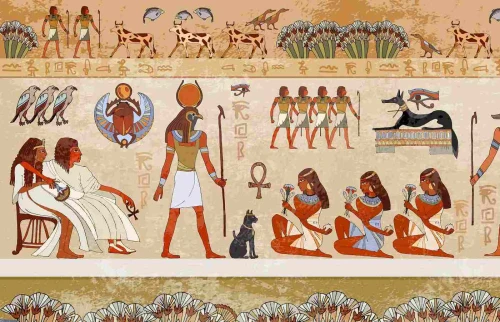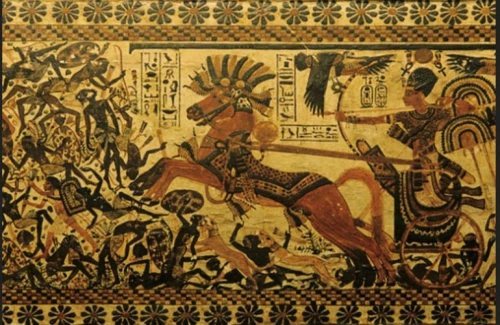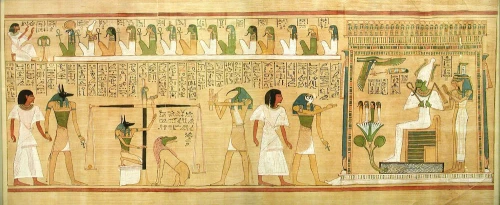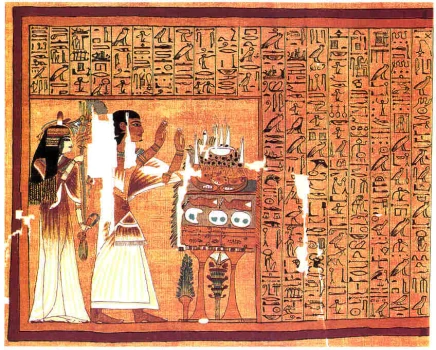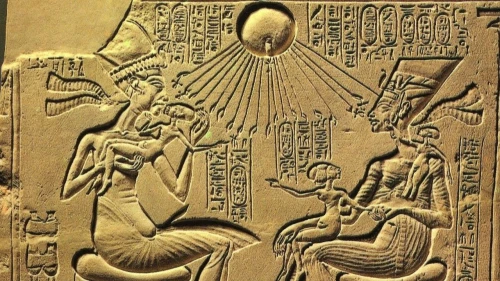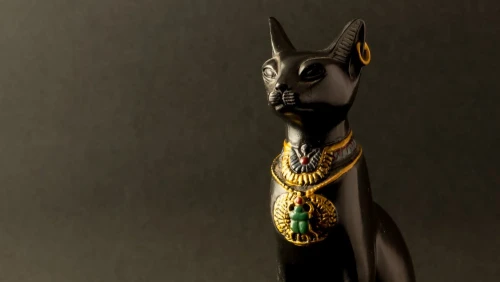
BASTET (BAST) Beloved cat goddess of the Egyptians
Bastet is the goddess of the Cats, with possible origins in the Libyan Desert. When Bastet is associated with ISIS she becomes the Soul of Isis, but as a goddess of music and dance, Bastet is linked with HATHOR Their cult instrument is the SISTRUM, which they carry as one of their attributes.
Bastet's cult city, Per-Bast (modern Bubastis), is located in the Delta and is mentioned in the Bible as Pibeseth (Ezekiel 30:17). Bastet's name is written with the bass jar (bs) and a loaf and means She of the base-jar a special vessel that holds perfume associated with her festivals.
During the OLD KINGDOM, Bastet was called "Goddess of the North", and in the PYRAMID TEXTS of King UNAS, she is nurse and mother of the king. When SEKHMET the lion goddess was named Lady of the West, Bastet became her counterpart as Lady of the East. Early depictions of Bastet show her with the head of a lion and associated with the lion-headed goddess, MUT. She is said to be the mother of MATHES, a lion-headed deity, and the wife of PTAH.
Like Sekhmet, Bastet has a dual personality, both gentle and fierce. Her association with Sekhmet reveals Bastet's aggressive and vengeful side. In one version of the mythology, Bastet becomes the daughter of the sun god Re, and when she is called upon to protect her father, Bastet becomes the fury in.
Bastet, the feline goddess, was most often represented as a cat-headed woman carrying a sistrum and an aegis. Because cats were favorite pets in Egypt, Bastet became a popular household goddess. (Photograph by Pat Remler) the eye of Re. As a dutiful daughter, she carried out the orders of Re and was the means of her father's vengeance.
Bye end of the NEW KINGDOM (1550 - 1069 B.C), Bastet had become a popular household goddess. Egyptian families welcomed her into their homes as the goddess of the hearth and protector of pregnant women. Her festivals were famous, and she was called goddess of plenty and mistress of pleasure. And as her popularity grew, her cult became well-known for its lavish festivals some of which were called Procession of Bastet, Bastet Protects the Two Lands, Bastet Goes Forth from Per-Bast (her city), Bastet Appears before Re, and the Festival of Hathor and Bastet. These joyous occasions involved days of music, dancing, and merriment throughout Egypt.
The Greek historian Herodotus provides a lively description of the devotees of the goddess as they made their way to the Festival of Bastet
When the Egyptians travel to Bubastis, [the city] they do so in this manner: men and women sail together, and in each boat, there are many persons of both sexes. Some of the women shake sacred rattles, [sistrum, pl.sistra] and some of the men play pipes during the whole journey, while others sing and clap their hands. If they pass a town on the way, some of the women shout and cheer at the local women, while others dance and create a disturbance. They do this in every town on the Nile. When they arrive at Bubastis, they begin the festival with great sacrifices, and on this occasion, more wine is consumed than during any other time of the year.
Herodotus, Histories, Book II, Chapter 60
The worshippers approached the temple singing, beating drums, and playing tambourines. Some carried sistra (sacred rattles) as they danced through the streets. Herodotus describes Bastet's lavish temple as standing on raised ground in the center of the city, so it was visible from every quarter. A TEMENOS wall decorated with various animals surrounded the temple. The inner courtyard was planted with a grove of trees.
So popular was Bastet that the Greeks identified her with their goddess Artemis. The third-century Roman poet Ovid refers to the goddess Bastet in his work Metamorphoses and said the goddess could turn herself into a cat. Bastet was most often shown with the body of a woman and the head of a cat, wearing a long, narrow, sheath-style dress with wide decorated bands over the shoulders. The goddess holds her sistrum in one hand, and in the other, she holds an AEGIS, a talisman representing a broad collar necklace with the head of a cat. Sometimes she is shown with kittens at her feet, a further depiction of her association with heart and family. The ancient Egyptian word for a kitten was new, pronounced meow the sound a cat makes. It became a term of endearment for children, who were called now-Sheri, little cat. Pilgrims traveled from all over Egypt to visit Bastet's temple and leave offerings to the goddess. Because the cat was sacred to Bastet, they left bronze statues, amulets, and mummified cats. Thousands of cat mummies have been discovered in underground crypts at the site of Bastet's temple in Bubastis.
 English
English
 Spain
Spain

